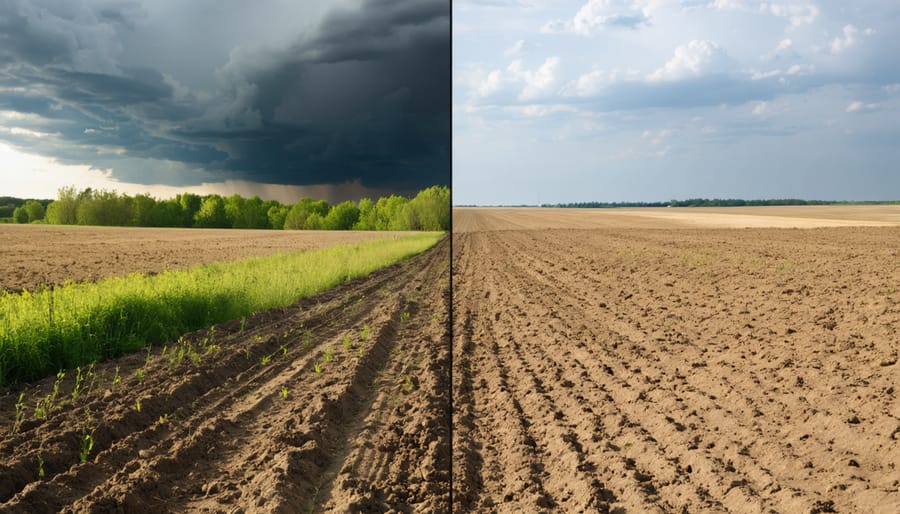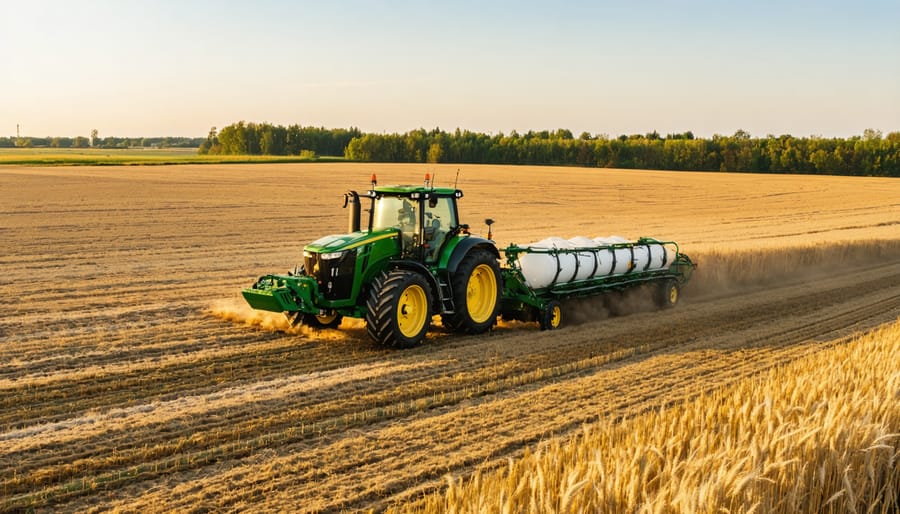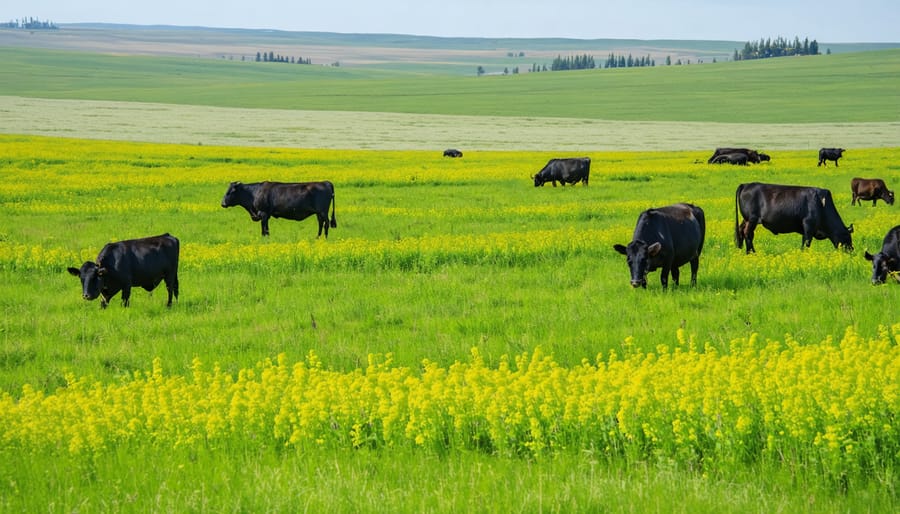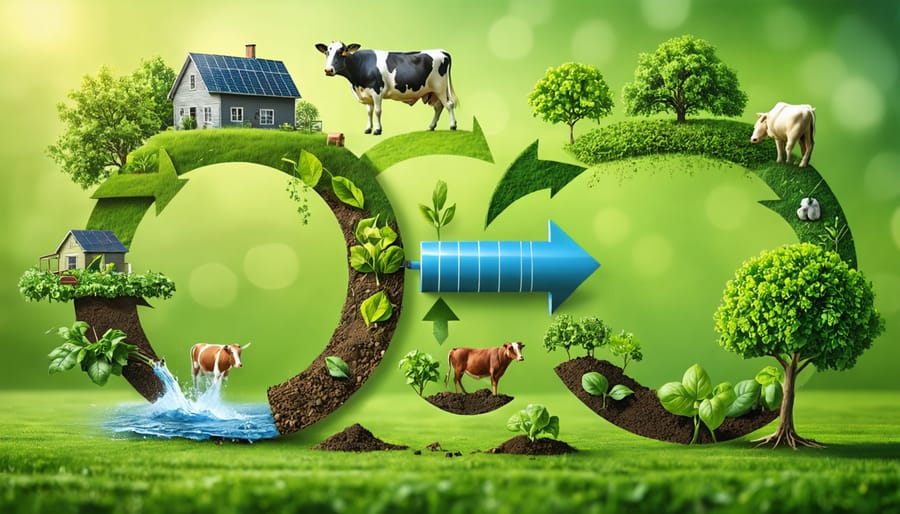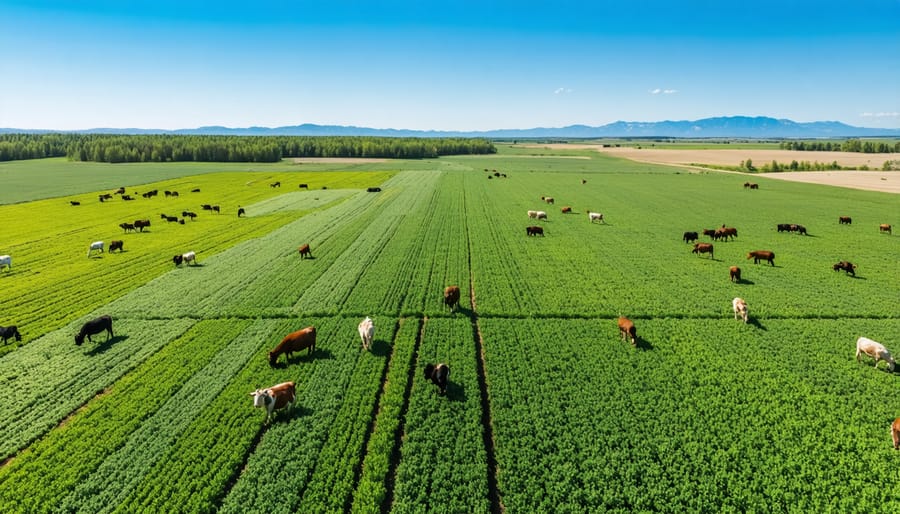Regenerating depleted soil transforms barren fields into thriving agricultural ecosystems across the Canadian Prairies. Through decades of intensive farming, our once-rich topsoil has lost up to 50% of its organic matter – but innovative farmers are reversing this trend using proven biological techniques that work with nature rather than against it.
By adopting strategic crop rotations, minimal tillage practices, and carefully managed livestock integration, Prairie producers are rebuilding soil organic matter at rates up to 1% per year while improving water retention by 25,000 liters per hectare. These regenerative methods not only restore soil health but also increase farm profitability through reduced input costs and enhanced crop resilience.
The science is clear: healthy soil teeming with beneficial microorganisms, mycorrhizal fungi networks, and stable organic matter creates the foundation for sustainable agriculture. As extreme weather events become more frequent across Alberta, farmers implementing soil regeneration techniques are better positioned to withstand both drought and flooding while producing nutrient-dense crops for their communities.
This practical guide explores field-tested soil building strategies specifically adapted for our northern growing conditions, backed by research from Canadian agricultural institutions and real-world success stories from local producers. Whether you manage a large-scale grain operation or a small market garden, these regenerative principles can be scaled to fit your unique context.
The Current State of Alberta’s Farm Soils
Alberta’s agricultural soils face unique challenges that have developed over decades of intensive farming practices. Recent soil surveys indicate that organic matter levels in many farming regions have declined by 30-50% compared to pre-cultivation levels. This decline particularly affects areas in central and southern Alberta, where conventional tillage practices have historically dominated.
Climate variability in the prairie region compounds these challenges. Many Alberta farmers report increasing difficulties with soil moisture retention, especially during the prolonged dry periods that have become more frequent in recent years. Wind erosion remains a significant concern, with an estimated 15% of Alberta’s agricultural land showing moderate to severe erosion risk.
Soil testing data from across the province reveals concerning trends in essential nutrients. Phosphorus levels are declining in about 40% of tested fields, while soil acidification is becoming more prevalent in northern regions. Additionally, soil compaction affects roughly 25% of Alberta’s farmland, particularly in areas where heavy machinery use has intensified.
However, it’s not all concerning news. A growing number of Alberta farmers are reporting success with soil improvement initiatives. For instance, farmers in the Parkland region have documented increases in soil organic matter of 1-2% over five years through modified management practices. These improvements demonstrate the potential for positive change.
Current soil health indicators show varying conditions across the province:
– Brown soil zones: Generally lower organic matter (2-3%)
– Dark Brown zones: Moderate organic matter (3-4%)
– Black soil zones: Higher organic matter (4-6%)
– Grey Wooded zones: Variable organic matter (2-5%)
Understanding these baseline conditions is crucial for implementing effective regeneration strategies. Local soil testing services and agricultural extension offices provide valuable resources for farmers looking to assess their specific soil conditions and develop targeted improvement plans.
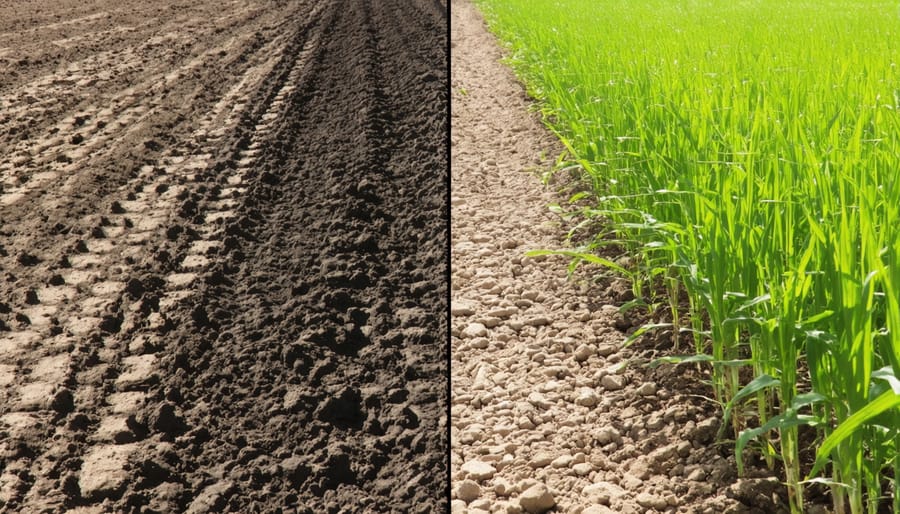
Core Soil Regeneration Practices
Cover Cropping Strategies for Prairie Conditions
In Alberta’s challenging prairie climate, selecting the right cover crops and implementing them effectively is crucial for soil regeneration success. Cold-hardy species like fall rye, winter triticale, and hairy vetch have proven particularly effective in our region, offering excellent soil protection during harsh winter conditions.
For early spring seeding, consider cool-season options like oats, peas, and crimson clover, which establish quickly and provide good biomass before the main crop season. These species help manage spring moisture and reduce wind erosion, a common challenge in prairie conditions.
Timing is critical – aim to seed winter-hardy cover crops by mid-September to ensure adequate establishment before freeze-up. For summer coverage between main crops, drought-tolerant species like sorghum-sudangrass and buckwheat work well, particularly in areas with limited rainfall.
Multi-species mixes often outperform single-species plantings in our climate. A popular prairie mix includes fall rye, field peas, and radish, combining different root structures and growth patterns to maximize soil benefits. This diversity helps build resilience against our variable weather conditions.
Consider soil moisture levels when planning your cover crop strategy. In drier years, reduce seeding rates and choose low-moisture species. Many Alberta farmers have found success using winter cereals as cover crops, which provide excellent snow capture for moisture conservation while protecting soil through winter months.
Remember to terminate cover crops early enough in spring to preserve soil moisture for your main crop, typically 2-3 weeks before seeding.
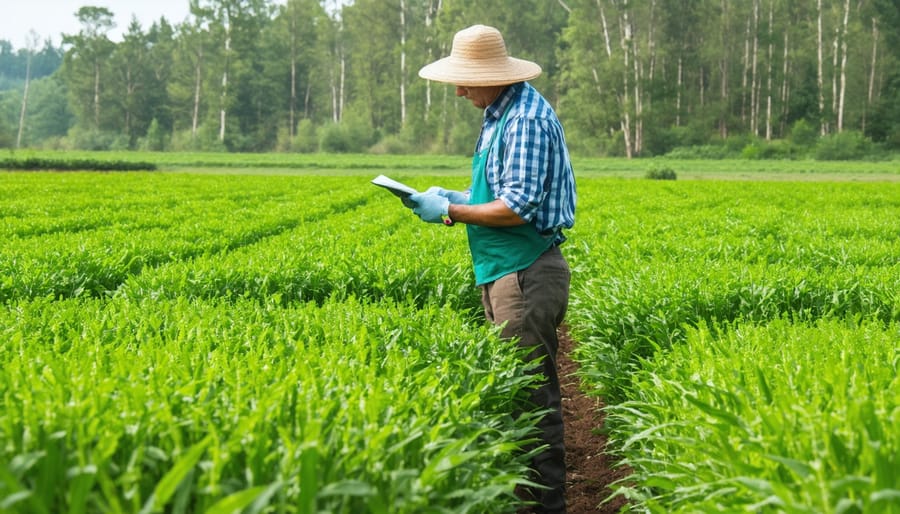
No-Till Implementation That Works
In Alberta’s challenging climate, successful no-till implementation requires careful planning and the right approach. Doug Miller, a third-generation farmer from Red Deer County, transitioned to no-till over five years, reporting a 30% reduction in fuel costs and improved soil moisture retention.
“The key is starting small and being patient,” Miller explains. “We began with a 40-hectare test plot, learning how to manage residue and handle different soil conditions before expanding.” His experience shows that beginning with cereal crops, which produce more stable residue, helps build confidence in the system.
Equipment modification plays a crucial role. Many Alberta farmers have found success by adjusting existing machinery rather than purchasing new implements. Essential modifications include adding weight to drills for better seed placement and installing residue managers to clear paths for seedling emergence.
Timing becomes particularly important in no-till systems. Successful practitioners recommend waiting for soil temperatures to reach 8°C before seeding, typically mid-April to early May in central Alberta. Soil moisture monitoring helps determine optimal planting conditions.
Cover crop integration strengthens no-till success. The Farming Smarter demonstration farm near Lethbridge showed that winter rye and field peas provide excellent soil coverage while improving nitrogen availability. Their three-year study demonstrated a 15% increase in organic matter content using this combination.
For those new to no-till, joining local farming networks and attending field days provides valuable practical insights and community support.
Crop Rotation Planning for Soil Health
Effective crop rotation is a cornerstone of soil regeneration, offering multiple crop rotation benefits that enhance both soil health and farm productivity. Here in Alberta, successful farmers typically follow a 4-5 year rotation pattern, alternating between cereals, oilseeds, pulses, and cover crops.
Start by planting nitrogen-fixing crops like field peas or fava beans in year one, followed by high-nutrient-demanding crops like canola in year two. Year three should feature cereals such as wheat or barley, while year four might include forage or cover crops that add organic matter to the soil.
For optimal results, consider these practical guidelines:
– Alternate between deep and shallow-rooted crops
– Include at least one legume crop in your rotation
– Plan for at least two years between similar crop types
– Incorporate winter cover crops when possible
– Monitor soil organic matter levels between rotations
Many Alberta farmers have found success by adapting their rotation schedule to local conditions. For instance, during drier years, including drought-resistant crops like rye or triticale can maintain soil coverage while requiring less moisture. During wetter seasons, taking advantage of moisture-loving crops like clover can maximize soil building potential.
Remember to keep detailed records of each field’s rotation history and soil test results to track improvements over time.
Advanced Soil Building Techniques
Biochar Applications in Prairie Soils
Biochar has emerged as a powerful soil amendment for prairie farmers, particularly in Alberta’s diverse agricultural landscape. This carbon-rich material, produced through pyrolysis of organic matter, offers multiple benefits when incorporated into prairie soils. Local studies have shown that biochar application rates of 10-20 tonnes per hectare can significantly improve soil structure and water retention capacity.
Prairie farmers implementing biochar have reported a 15-25% increase in water holding capacity, particularly beneficial during drought conditions common to Alberta. The material’s porous structure creates essential habitat for beneficial soil microorganisms, while its stable carbon content contributes to long-term soil carbon sequestration.
In the Alberta context, biochar produced from locally available materials such as wood waste and crop residues has proven most cost-effective. Several innovative farmers in Central Alberta have successfully integrated biochar with their existing composting operations, creating enriched soil amendments that combine the benefits of both materials.
When applying biochar, timing is crucial. Early spring or fall application allows the material to integrate with the soil before the growing season. Many Alberta farmers have found success mixing biochar with liquid manure or compost before application, which helps prevent wind displacement and accelerates the biochar’s activation in the soil.
Remember to start with small test plots to determine the optimal application rate for your specific soil conditions. Local agricultural extension services can provide guidance on sourcing and applying biochar effectively in your operation.
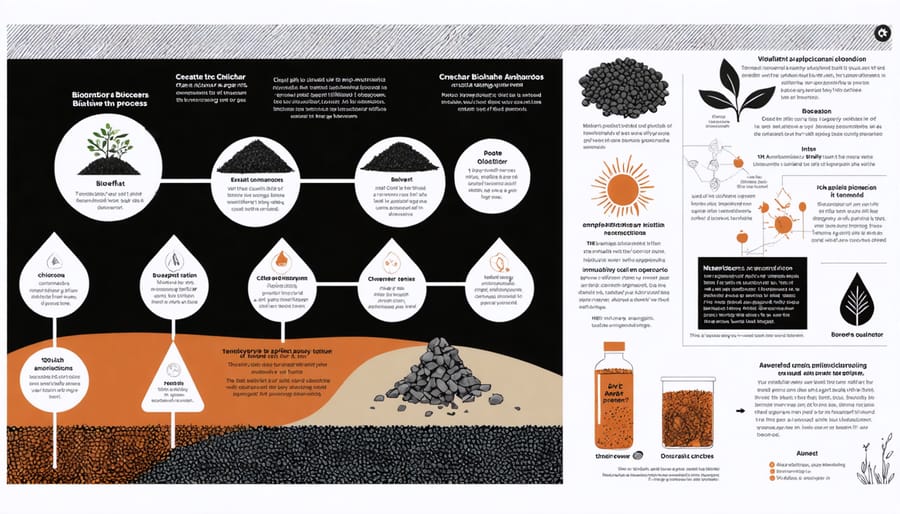
Compost Tea and Biological Amendments
Compost tea has become a game-changer for many Alberta farmers looking to boost their soil’s biological activity. This nutrient-rich liquid amendment is made by steeping finished compost in water, creating a concentrated brew of beneficial microorganisms. To make effective compost tea, start with high-quality compost from local sources and aerate the mixture for 24-48 hours while maintaining a temperature between 18-21°C.
For best results, apply compost tea during the early morning or late evening when UV exposure is minimal. A typical application rate is 50-100 litres per hectare, though this may vary based on your soil conditions. Many Prairie farmers report success using boom sprayers or irrigation systems for even distribution.
Beyond compost tea, other biological amendments like mycorrhizal fungi inoculants and bacterial solutions can significantly enhance soil health. These amendments work particularly well in our Prairie soils, where harsh winters can deplete microbial populations. Local success stories include the Davidson family farm near Red Deer, which saw a 30% increase in soil organic matter over five years using a combination of compost tea and targeted biological amendments.
Remember to test your soil regularly to monitor the effectiveness of these amendments. Many farmers find it helpful to maintain detailed records of application timing and rates, correlating them with soil test results and crop performance.
Managed Grazing for Soil Enhancement
Managed grazing represents one of the most effective ways to enhance soil health while maintaining productive agricultural operations. By implementing integrated livestock systems, Alberta farmers can significantly improve soil structure, organic matter content, and nutrient cycling.
The key to successful managed grazing lies in timing and intensity. Rotating livestock through paddocks allows plants to recover between grazing periods, typically requiring 20-30 days of rest in Alberta’s climate. This practice promotes deeper root development and increases soil carbon sequestration.
For optimal results, maintain grass height between 10-15 centimetres and avoid overgrazing. Multi-species grazing, combining cattle with sheep or goats, can help control weeds while diversifying the impact on soil biology. Consider using portable electric fencing to create flexible paddock systems that can be adjusted based on seasonal conditions and forage availability.
Many Alberta ranchers have found success with adaptive multi-paddock grazing, reporting improved water retention and decreased soil compaction within two growing seasons. This approach particularly benefits areas prone to drought, as healthy soils can store up to 25% more water than degraded pastures.
During winter months, implement bale or swath grazing to maintain soil coverage and naturally distribute nutrients through manure. This strategy reduces feed costs while continuing to build soil organic matter even during dormant periods.
Measuring Success: Soil Health Indicators
Simple Field Tests for Farmers
As Alberta farmers, we can assess our soil health right in the field using these simple yet effective tests. The jar test is one of the most reliable methods – fill a clear jar one-third full with soil, add water, shake well, and let it settle for 24 hours. The layers that form will show your soil’s composition of sand, silt, and clay.
The shovel test reveals soil structure and biological activity. Dig a 30-cm deep hole and examine the soil layers. Healthy soil should crumble easily and contain visible organic matter, earthworms, and root networks. Look for a dark, rich colour indicating good organic content.
To check soil infiltration, push an empty 15-cm diameter pipe 7 cm into the ground and pour 500 mL of water inside. Time how long it takes to drain – healthy soil should absorb water within 3-5 minutes. Longer drainage times may indicate compaction issues.
The smell test is surprisingly informative. Fresh, healthy soil has a pleasant earthy aroma caused by beneficial microorganisms. A sour or metallic smell could indicate poor drainage or anaerobic conditions.
Finally, the underwear test has become popular among prairie farmers – bury a pair of 100% cotton underwear 15 cm deep and check it after two months. The more decomposed the fabric, the more biological activity in your soil. These simple tests help track your soil’s improvement as you implement regenerative practices.
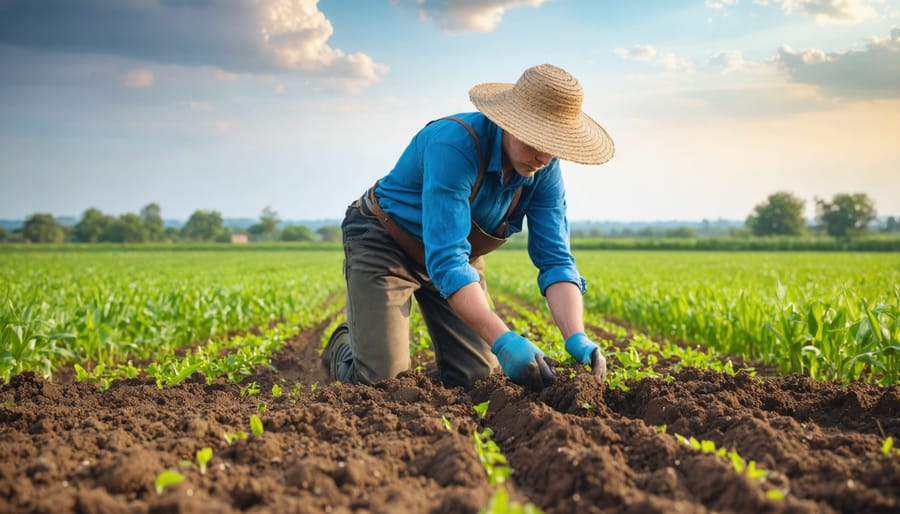
Professional Soil Analysis Guide
Professional soil analysis is a cornerstone of successful regenerative farming in Alberta. Working with accredited labs like the Agricultural Services Laboratory in Edmonton or local extension offices provides detailed insights into your soil’s composition and health. These services typically analyze pH levels, organic matter content, nutrient availability, and microbial activity.
To get the most accurate results, collect soil samples from multiple locations across your field, focusing on areas with different crop performance or visible soil variations. Take samples at consistent depths (usually 0-15 cm for topsoil analysis) and avoid sampling immediately after fertilizer application or during extremely wet conditions.
Modern soil monitoring systems can complement lab testing by providing real-time data on moisture levels, temperature, and nutrient fluctuations. Many Alberta farmers find success by combining annual professional testing with ongoing monitoring.
Understanding your test results helps develop targeted improvement strategies. Local agronomists and soil specialists can help interpret complex reports and recommend specific amendments suited to Prairie conditions. Consider joining regional soil health networks to share experiences and testing strategies with fellow farmers. Regular testing, typically conducted in spring or fall, helps track progress and adjust regeneration practices for optimal results.
Economic Benefits and Implementation Timeline
Implementing soil regeneration techniques offers significant returns on investment, though results typically develop over multiple growing seasons. Based on data from Alberta farms, initial costs range from $100 to $300 per hectare, depending on chosen methods and existing soil conditions.
Most farmers see positive financial impacts within 2-3 years through reduced input costs and improved yields. Local case studies show 15-25% savings on fertilizer expenses and up to 30% reduction in irrigation needs by year three. Soil organic matter typically increases by 0.5-1% annually when following comprehensive regeneration practices.
A practical implementation timeline often looks like this:
Year 1: Initial soil testing and baseline establishment ($2-3 per acre)
Years 1-2: Cover crop integration and reduced tillage ($45-75 per acre annually)
Years 2-3: Establishment of crop rotation systems
Years 3-5: Full regenerative system integration
Government programs through the Canadian Agricultural Partnership can offset up to 50% of implementation costs. The Environmental Farm Plan program offers additional funding support for soil improvement initiatives.
Return on investment accelerates over time. Alberta farmers report breaking even by year 3, with profit margins increasing by 10-15% by year 5 through combined savings on inputs and improved crop resilience. Long-term benefits include enhanced drought resistance and reduced erosion-related losses, providing lasting economic advantages for farm operations.
Soil regeneration isn’t just about improving our land – it’s about securing the future of Canadian agriculture. By implementing these regeneration techniques, Alberta farmers are already seeing remarkable improvements in soil health, crop yields, and farm resilience. The key is to start small, measure progress consistently, and adjust practices based on your specific soil conditions and farming goals.
Remember that success in soil regeneration comes from a combination of practices: cover cropping, minimal tillage, proper rotational grazing, and maintaining living roots in the soil as much as possible. The investment in soil health today will pay dividends for generations to come, both environmentally and economically.
Take the next step by selecting one or two techniques that best suit your operation and implement them this growing season. Connect with local agricultural extension services, join farmer-led soil health groups, and share your experiences with fellow producers. Together, we can build a more sustainable and profitable agricultural future for Alberta while preserving our precious soil resources for the next generation of farmers.

